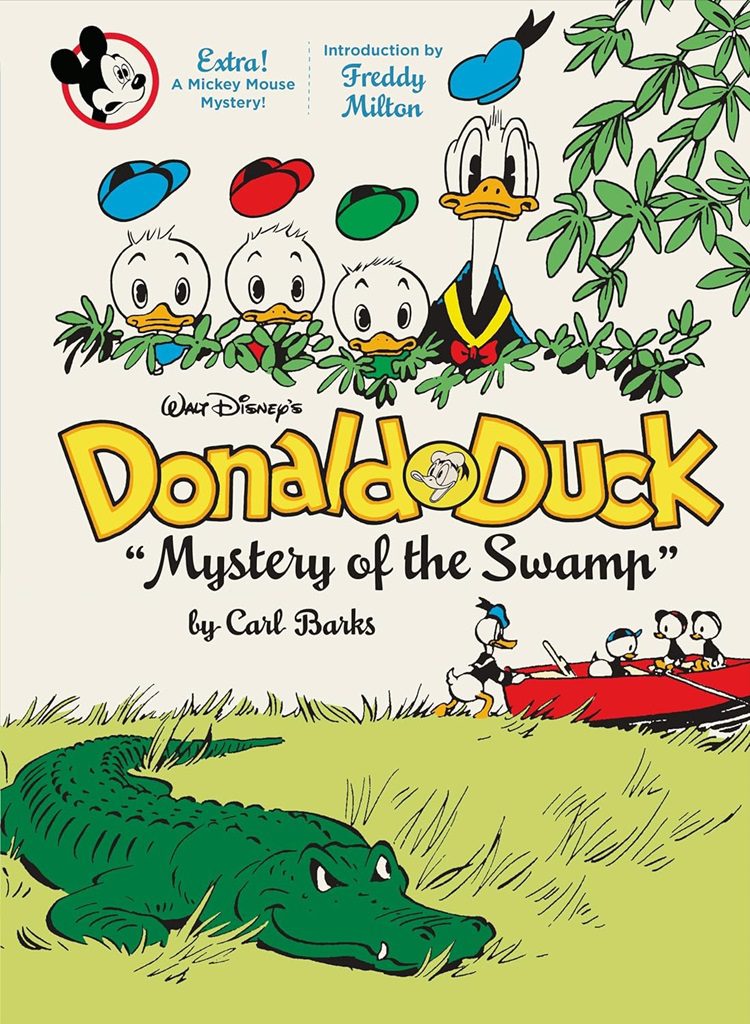
Walt Disney’s Donald Duck “Mystery of the Swamp” is Volume 3 in Fantagraphics’s The Complete Carl Barks Disney Library. The book collects comic book stories from January 1945 – May 1946 featuring Donald and his nephews: Huey, Dewey, and Louie. It opens with an Introduction by Danish comic artist and writer Freddy Milton, who was first introduced to Barks’s work in “Donald’s Monster Kite”; and concludes with “Story Notes,” annotations by a team of writers, and “Carl Barks: Life Among the Ducks,” a biography by Donald Ault.
Buy Walt Disney’s Donald Duck “Mystery of the Swamp” by Carl BarksRegardless of the chronological order of the stories arranged in previous volumes, I have read the books I have reviewed in the order Fantagraphics arranged them. However, with this book, I went straight to the final story, credited as the “only Mickey Mouse story” that Barks drew. The unknown author of “Mickey Mouse and the Riddle of the Red Hat” tells a funny case of mistaken identity involving Mickey, his girlfriend Minnie Mouse, and the Faith Ruby jewel. Goofy makes an appearance, unintentionally helping to save the day.
Barks seems to have been inspired by adventure stories involving hidden tribes. In the titular story Donald and the boys find Gneezles (or did the Gneezles find them?) living among the Everglades. The story has both funny and suspenseful moments but the tension is lost by the end when it gets magically wrapped up by the ducks being given “ferettin juice.” They later find cavemen living within the Grand Canyon in “Taming the Rapids,” but make no mention upon their return.
Pride is typically the cause of Donald problems. He thinks he can get rich from running “The Tramp Steamer,” thinks he can tame a horse in “Webfooted Wrangler” and also “Days at the Lazy K,” battles a woodpecker he wants to photograph for prize money in “Pecking Order,” and tries his hand at water skiing in “The Great Ski Race” because the kids earned reward money in a previous story, a surprising moment of continuity in what are usually self-contained stories.
In these early years, Barks shows the nephews are single-minded, often speaking one after another to complete sentence. They have a very antagonistic relationship with their uncle. It’s clear early on who “The Icebox Robber” is. Yet without proof, Donald thinks the boys did it and gives them each a spanking with a switch, an item he goes for multiple times in this volume when angered by them.
Donald messing with his nephews is a frequent plot device. “The Long Race to Pumpkinburg” is a funny variation on Aesop’s “The Hare & the Tortoise” with Donald ice-skating against his nephews. It’s odd that he cheats so much when it appears he could easily beat them, but no surprise when Barks gives him a deserving comeuppance. While they play detective in “Thug Busters,” he wears a costume that looks like an early version of a Beagle Boy.
Donald also teaches them no good deed goes unpunished when he makes the boys return a found $10 in Ten-Dollar Dither.” Barks might be commenting on society as a lot of dishonest folks show up to claim it. In Barks’s first Xmas-themed Duck story, “Donald Duck’s Best Christmas” the boys do the right thing again and this time get rewarded although doing the right thing was reward enough for them.
But Huey, Dewey and Louie aren’t always little angels. They keep trying to sneak away from home to avoid doing chores in “Eyes in the Dark” and end up paying for it. When Daisy suggests “Donald Tames His Temper,” the boys comically take advantage of their uncle’s restraint. And they cause Donald an amusing bit of trouble when they bring home pestering parrot “Singapore Joe,” who secretly insults passersby from inside Donald’s house
But it’s clear they care for their uncle. They rescue him and a lady in “Jet Rescue” even though they wouldn’t have been able to if they had initially listened to his suggestion. And in the wildest of the stories I have read so far, the boys try to contain Donald and hide him from the law when he becomes “The Firebug” after banging his head falling down the stairs. A doctor diagnoses him as a pyromaniac, and when fires break out all over the city, he’s obviously a suspect. It seems a reckless idea for children to read even when the mystery is explained.
Barks stories are a fun blend of adventure and comedic antics, many times both happening in the same story, but the artwork is the definite highlight of the book. He has such a mastery of his art. The settings are filled with such detail one will want to slowly pore over them that if the stories weren’t so engaging, there would be no hurry to the next panel. The characters are drawn with such expression that their moods pop off the page before reading the word balloons. “Mystery of the Swamp” is another wonderful addition to the Carl Barks Disney Library.